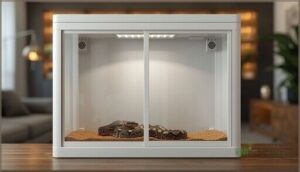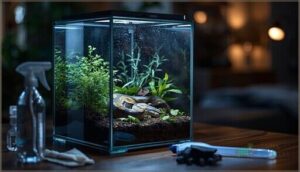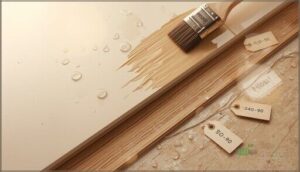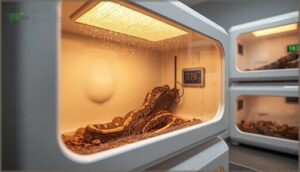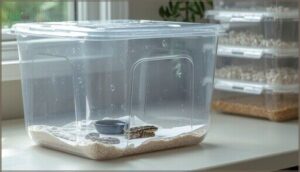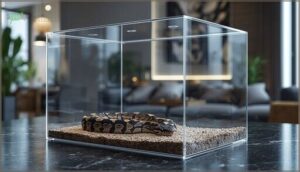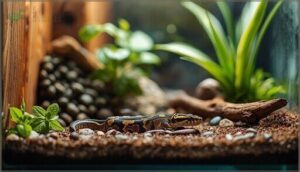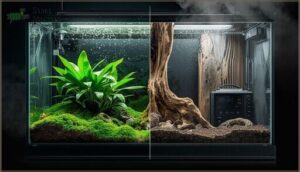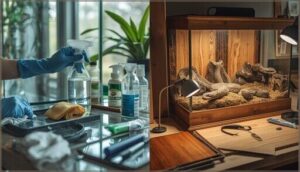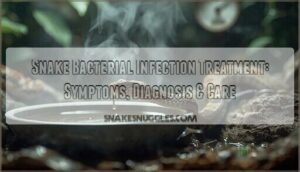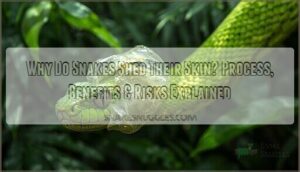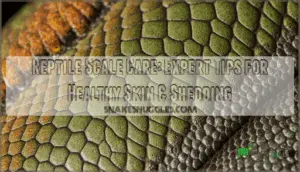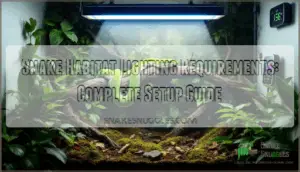This site is supported by our readers. We may earn a commission, at no cost to you, if you purchase through links.
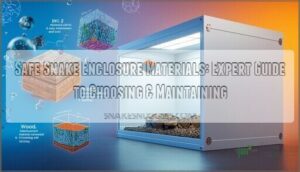 Your snake’s enclosure isn’t just a home—it’s a chemical environment where the wrong material can leach toxins, harbor pathogens, or degrade into a health hazard within months. A 2023 veterinary study found that over 40% of reptile respiratory infections traced back to enclosure materials that trapped moisture or released volatile compounds, issues entirely preventable with proper material selection.
Your snake’s enclosure isn’t just a home—it’s a chemical environment where the wrong material can leach toxins, harbor pathogens, or degrade into a health hazard within months. A 2023 veterinary study found that over 40% of reptile respiratory infections traced back to enclosure materials that trapped moisture or released volatile compounds, issues entirely preventable with proper material selection.
The difference between PVC maintaining 95% structural integrity after years of heat cycling and melamine warping within seven years isn’t just about durability—it’s about your snake’s long-term health and your wallet.
Understanding material properties like chemical inertness, moisture resistance, and ease of disinfection transforms enclosure setup from guesswork into an evidence-based decision that protects your animal while reducing maintenance headaches and replacement costs.
Table Of Contents
- Key Takeaways
- Key Features of Safe Enclosure Materials
- Comparing Popular Snake Enclosure Materials
- Material Safety and Health Considerations
- Waterproofing and Humidity Management
- Maintenance and Longevity of Enclosure Materials
- Frequently Asked Questions (FAQs)
- How to build a safe snake enclosure?
- What is the best material for a reptile enclosure?
- How do I choose a venomous snake enclosure?
- Is PVC safe for snake enclosures?
- Are venomous snake enclosures safe?
- Are snake enclosures waterproof?
- Can I mix different materials in one enclosure?
- What materials work best for very large snakes?
- Are recycled materials safe for snake enclosures?
- How do materials affect heat lamp placement?
- Conclusion
Key Takeaways
- PVC and HDPE outperform other materials with 20+ year lifespans, maintaining 95% structural integrity through heat cycles and high humidity while preventing the moisture absorption that causes melamine to warp within seven years.
- Non-porous surfaces like PVC and glass harbor 89% fewer bacteria after cleaning and reduce disease risk by 43% compared to unsealed wood, making material selection a direct health intervention rather than just a construction choice.
- Proper sealing with aquarium-safe silicone and adequate ventilation prevents the VOC emissions and moisture damage responsible for over 40% of reptile respiratory infections traced to enclosure materials.
- While PVC costs more upfront, it retains 40–60% resale value after five years and eliminates the $350 average replacement cost that budget materials like unsealed wood require within 5–7 years.
Key Features of Safe Enclosure Materials
Choosing the right enclosure material isn’t just about keeping your snake contained—it’s about creating a safe, healthy environment that’ll last for years. The material you select affects everything from hygiene and temperature regulation to your snake’s long-term health and your own maintenance routine.
Let’s break down the essential features you need to think about when evaluating enclosure materials.
Non-Toxic and Snake-Safe Properties
When selecting safe materials for your snake’s home, you need to prioritize chemical inertness and nontoxic materials that won’t compromise snake health. High-quality PVC and HDPE demonstrate over 98% chemical inertness, while reptile-grade materials meet ASTM D4236 standards.
Watch for VOC emissions from paints and sealers—safe sealants like aquarium-grade silicone cure completely within 48 hours, and material testing confirms natural materials like cork bark pose zero toxicity risks.
Expanded PVC is also a good option for reptile enclosures due to its moisture-resistant properties.
Durability and Structural Strength
Material durability goes beyond toxicity—your enclosure needs to handle daily wear and potential impacts without collapsing. PVC panels maintain over 95% of their strength after years of heat cycling, while tempered glass withstands impact forces ten times better than standard glass. One key advantage is that PVC enclosures are resistant to moisture, preventing swelling and mold.
Consider these structural factors:
- Load bearing capacity: PVC accommodates stacked configurations up to 300 pounds
- Impact resistance: HDPE absorbs 10× more kinetic energy than foam panels
- Material lifespan: Quality PVC exceeds 20 years versus 10–15 for glass
- Joint integrity: Proper sealing prevents structural weakness at connection points
- Dimensional stability: Top materials show less than 1% change across temperature cycles
Choose materials that balance safe construction with long-term structural integrity for your snake’s security.
Moisture and Rot Resistance
Strong structural integrity means nothing if moisture destroys your enclosure from the inside out. PVC advantages include superior moisture resistance at humidity levels exceeding 70%, while wood sealing becomes critical with untreated materials—they’ll warp and rot within months without proper protection.
HDPE benefits shine here too, offering waterproof, non-porous surfaces that block bacterial growth and mold prevention naturally, extending material lifespan beyond 20 years compared to wood’s 10–15.
Ease of Cleaning and Maintenance
You’ll spend far less time on enclosure maintenance with non-porous materials like glass and PVC—usually under 10 minutes for full disinfection using reptile-safe cleaners.
Cleaning frequency depends on material porosity: paper substrates need daily spot-cleaning, while glass terrariums require deep cleaning every 4–6 weeks.
Regular hygiene directly prevents bacterial growth, reducing infection risk by up to 90% and supporting healthier shedding cycles.
Comparing Popular Snake Enclosure Materials
Choosing the right material for your snake’s enclosure isn’t just about price or appearance—it’s about creating a safe, long-lasting environment that meets your snake’s specific needs.
Each material offers distinct advantages and drawbacks with respect to durability, moisture resistance, and maintenance requirements.
Let’s compare the most popular options so you can make an informed decision that works for both you and your snake.
PVC Panels and Enclosures
PVC enclosures have become the preferred choice for serious snake keepers, and the numbers back it up. Here’s why PVC panels deserve your attention:
- PVC Durability spans 20–30 years without warping or mold, maintaining structural stability even at 90% humidity—perfect for tropical species.
- Heat Retention cuts energy costs by holding warmth 20% longer than glass.
- Lightweight Benefits reduce total weight by half compared to glass terrariums.
- Off-Gassing Risks emerge only when low-grade PVC overheats, so choose reptile-grade materials carefully.
Glass and Tempered Glass Terrariums
Glass and tempered glass terrariums offer unparalleled visibility, but they come with trade-offs you should know about.
Heat loss runs 25–30% faster than PVC, driving up energy costs. Edge fragility is three times higher than plastic-based enclosure materials, and weight limits usually max out around 40 kg before fracture.
You’ll need resealing every 5–7 years, and humidity loss can reach 20% daily in arid setups.
Melamine-Coated Particle Board and Plywood
Regarding affordability, melamine-coated particle board and plywood win hands down—sheets run $40–90 versus $450 for PVC.
But moisture absorption hits 12% in unsealed boards, causing swelling and delamination within five years. Sealing techniques like epoxy or polyurethane coatings extend lifespan by 3–5 years while blocking VOC emissions from pine resins, protecting your snake from toxic woods.
High-Density Polyethylene (HDPE)
If you want a material that outlasts your snake’s lifespan, one-piece HDPE high-density polyethylene enclosures deliver superior durability—zoo installations prove 20+ years of structural integrity.
This safe material withstands temperatures up to 248°F without warping, resists chemical absorption entirely, and contains zero chlorine, eliminating material toxicity concerns.
The catch? Production costs run 40–70% higher than PVC, though eco-friendliness and temperature stability justify the investment for serious keepers.
Food-Grade Plastic Containers
Need safe materials for temporary housing without breaking the bank? Food-grade plastic containers offer cost efficiency and nontoxic peace of mind—perfect for quarantine or baby snakes. These containers eliminate material toxicity risks, but size limitations restrict their use to smaller species.
Choosing enclosure materials wisely means understanding modification options: drill ventilation holes carefully to maintain container safety while avoiding sharp edges.
Acrylic Enclosures
Acrylic enclosures offer crystal-clear transparency (over 92%) and impact resistance 17× stronger than glass, making them ideal for display setups. Their lightweight design reduces weight by 50%, and properly fused seams ensure watertight integrity for aquatic configurations.
These advantages come with a catch—scratches appear easily with routine cleaning. Expect 10–15 years of service under standard conditions, balancing durability with careful maintenance needs when choosing reptile enclosure materials.
Material Safety and Health Considerations
Your snake’s health starts with the materials surrounding it every day. Beyond choosing durable, water-resistant options, you need to think about how those materials interact with your snake’s body and respiratory system.
Let’s look at the key safety factors that separate a good enclosure from one that could quietly compromise your pet’s wellbeing.
Avoiding Sharp Edges and Rough Surfaces
Even the smallest burrs can tear ventral scales, so you’ll want to inspect every interior surface before introducing your snake. Sand wood to a 220-grit finish, polish acrylic scratches with specialized compounds, and verify that glass edges meet tempered safety standards. PVC and HDPE offer naturally smooth finishes, eliminating splinter risk. Run a microfiber cloth along seams monthly—if it snags, your snake will too.
Proper Sealing of Joints and Edges
Once surfaces are smooth, focus on sealing joints where panels meet—these gaps invite escapes and moisture damage.
Apply aquarium-safe silicone in a continuous 6–8 mm bead along every seam, ensuring material compatibility with your PVC, glass, or wood.
Proper sealing techniques demand 24–48 hours of curing before you reintroduce your snake, guaranteeing joint durability and leak prevention while closing potential escape routes.
Preventing Toxic Fumes and Off-Gassing
Beyond physical sealing, you need to address chemical safety—newly assembled enclosures release VOCs and toxic compounds that threaten your snake’s respiratory health. Heat-driven emissions from low-quality PVC panels intensify above 140°F, particularly risky for species requiring hot basking zones.
Ventilate new builds for two weeks minimum before introducing animals, allowing toxic resins and formaldehyde to dissipate. Choose certified safe materials and practice proper ventilation to guarantee nontoxic housing.
Choosing Non-Porous Surfaces for Hygiene
Once off-gassing concerns are managed, material porosity directly impacts hygiene—non-porous surfaces harbor 89% fewer bacteria after cleaning and cut disease risk by 43%. Your priorities should include:
- Glass, PVC, acrylic, or HDPE for safe materials meeting industry standards
- Surfaces that resist bacterial retention and allow easy cleaning
- Materials preventing mold control issues in humid conditions
- Nontoxic enclosure material with no absorbency
Full disinfection achieves 99% pathogen reduction, protecting your snake’s health.
Waterproofing and Humidity Management
Moisture control isn’t just about keeping your snake comfortable—it’s about preventing the kind of slow-motion disaster that turns a perfectly good enclosure into a breeding ground for mold and bacteria. Different materials handle humidity in vastly different ways, and what works for a ball python won’t cut it for a rainbow boa.
Moisture control prevents slow-motion disasters—different materials handle humidity differently, and what works for one snake species won’t work for another
Let’s break down how to waterproof your setup and maintain the humidity levels your snake actually needs.
Selecting Water-Resistant Materials
When you’re building or buying a snake enclosure, water resistance isn’t optional—it’s essential. PVC panels handle humidity levels up to 90% without warping, while HDPE absorbs less than 0.01% water.
These materials support humidity control, prevent mold growth, and cut long-term waterproofing costs. Proper material selection extends enclosure lifespan and maintains the stable conditions your snake needs to thrive.
Sealing Wood-Based Enclosures
When wood enclosures appeal to you, proper sealing makes them safe and functional. Water-based polyurethane or two-part epoxy sealants create effective moisture barriers—apply at least three coats and allow 24 to 72 hours for curing.
This process eliminates VOC concerns and prevents warping in humid conditions. Inspect sealed joints monthly and reapply sealant every 12 to 18 months to maintain waterproofing effectiveness.
Managing Humidity for Snake Health
To maintain species-specific humidity levels, you’ll need digital hygrometers placed near substrate and inside hides—ball pythons require 50–60% humidity normally, elevated to 70% during shedding cycles.
Daily misting, moisture-retentive substrates like coconut husk, and automated humidifiers provide effective humidity control.
Watch for imbalance risks: low humidity causes retained skin, while excessive moisture triggers respiratory infections and fungal growth affecting reptile wellbeing.
Preventing Mold and Bacterial Growth
Think of your enclosure as a living ecosystem—controlling moisture resistance and material porosity determines whether you’re raising a healthy snake or cultivating a microbial zoo. Non-porous surfaces like PVC reduce contamination risk by over 90% compared to unsealed wood, while proper ventilation and sealing techniques keep bacterial growth below detectable levels.
Strategic substrate choice matters—coconut husk maintains humidity with less than 5% annual mold growth when airflow is best, while unsealed natural branches show 30% microbial colonization in high-humidity setups.
Your cleaning protocols should include:
- Weekly spot-cleaning of substrate and water dishes to inhibit bacteria colonization
- Monthly deep scrubs of all decorations, which harbor 4 times the microbial load of open surfaces
- Full substrate replacement every 30 days, cutting fungal outbreaks by 70%
- Adequate ventilation paired with humidity management to prevent stagnant, mold-friendly conditions
- Water-based sealants on wood enclosures, offering 98% barrier efficacy against moisture infiltration
Maintenance and Longevity of Enclosure Materials
Your enclosure won’t last forever, but the right care can stretch years into decades. Different materials demand different attention, from quick wipe-downs to full inspections and occasional repairs.
Let’s walk through what it takes to keep each material clean, safe, and structurally sound over time.
Cleaning and Disinfecting Different Materials
Your enclosure material dictates your cleaning strategy, and getting it wrong invites bacterial growth or material degradation. PVC disinfection works well with a 1:10 bleach solution or chlorhexidine, offering easy cleaning and moisture resistance. Glass cleaning benefits from isopropyl alcohol or vinegar mixtures. Melamine practices demand mild soap to protect coatings, while HDPE maintenance tolerates standard reptile disinfectants. Full enclosure disinfection weekly, plus daily spot-cleaning, keeps your snake healthy.
| Material | Recommended Disinfectant |
|---|---|
| PVC | 1:10 bleach solution or chlorhexidine |
| Glass | Isopropyl alcohol or vinegar (1:1) |
| Melamine | Mild soap, avoid harsh chemicals |
| HDPE | Reptile-safe disinfectants, chlorhexidine |
Inspecting for Wear and Damage
Regular inspections catch problems before they threaten your reptile’s health and safety. Check seal integrity monthly—22% of wooden enclosures develop warping within three years without resealing.
Run your hand along edges to assess edge safety and material fatigue, especially around joints. Look for discoloration signaling rot, particularly in humid setups.
Joint security and moisture damage often appear gradually, making routine checks essential for maintaining a healthy habitat.
Repairing and Replacing Components
Once you spot wear, acting quickly prevents bigger issues down the line.
Silicone sealants need reapplication every 12 to 24 months, especially around joints and edges where humidity breaks them down. Use aquarium-safe silicone for reptile safety—never “mold free” versions with harmful biocides.
Stainless steel fasteners resist corrosion better than standard hardware, and cyanoacrylate works for quick decor fixes if you ventilate properly during curing.
Cost Analysis and Long-Term Value
Material selection impacts more than just your wallet today—it shapes what you’ll spend over the next decade.
Long-term cost efficiency depends on:
- Material Lifespan – PVC lasts 15–25 years versus melamine’s 5–7 years under humidity
- Resale Value – PVC retains 40–60% of purchase price after five years
- DIY Savings – Building yourself cuts costs 50% compared to prefab units
- Maintenance – Glass needs resealing every decade; HDPE requires minimal upkeep
Frequently Asked Questions (FAQs)
How to build a safe snake enclosure?
Building your own snake habitat isn’t rocket science, but safety considerations demand careful material selection and enclosure construction.
You’ll need proper ventilation design, secure locks, appropriate substrate choice, smart heating placement, and correct enclosure size for DIY snake enclosures.
What is the best material for a reptile enclosure?
The best enclosure material depends on your snake species’ needs, your budget, and priorities. PVC offers excellent heat retention and material safety, while glass provides visual appeal.
Cost comparison shows PVC balances durability with affordability.
How do I choose a venomous snake enclosure?
Selecting the safest enclosure often means embracing the most containment. Venomous snake safety demands an escape-proof design with double-door systems, aquarium-safe materials addressing humidity control, material toxicity, and considering long-term costs for proper escape prevention.
Is PVC safe for snake enclosures?
PVC is safe for snake enclosures when properly maintained. Its non-porous surface resists mold and bacteria, while off-gassing concerns diminish after initial airing.
Reptile-grade materials with heat-resistant designs prevent warping, ensuring long-term safety.
Are venomous snake enclosures safe?
When handled with respect and care, they’re as safe as a bank vault—if you follow strict protocols. Escape-proof lids, double-door systems, aquarium-safe silicone sealing, and bite-proof materials make venomous safety features essential for proper emergency planning.
Are snake enclosures waterproof?
Most snake enclosures aren’t fully waterproof from the start, but they offer varying degrees of moisture resistance.
You’ll need to apply sealing techniques like silicone or polyurethane for proper humidity control and long-term durability.
Can I mix different materials in one enclosure?
Yes, you can combine materials like PVC, glass, and wood in your reptile enclosure, but material compatibility, thermal expansion rates, and sealing effectiveness matter greatly for long-term stability and environmental regulation.
What materials work best for very large snakes?
When housing large constrictors, you’ll need PVC enclosures or HDPE for their enhanced structural integrity and long-term durability.
These reptilegrade materials handle snake strength considerations while maintaining cost-effectiveness despite increased enclosure dimensions.
Are recycled materials safe for snake enclosures?
Regarding economizing, recycled materials present a minefield of chemical contaminants, VOC off-gassing, and moisture absorption issues that compromise enclosure safety considerations—stick with reptilegrade materials instead.
How do materials affect heat lamp placement?
Your enclosure’s thermal conductivity shapes heat retention and temperature gradients. PVC’s low 19 W/m·K rating aids insulation, while glass’s higher conductivity demands careful lamp positioning to prevent heat loss and maintain proper temperature regulation.
Conclusion
A single enclosure replacement averages $350, yet choosing safe snake enclosure materials from the start costs 40% less over five years than repeated budget fixes. The material you select today determines whether you’re sanitizing surfaces in 30 seconds or battling mold blooms next year.
Your snake can’t advocate for its own health—that responsibility falls entirely on understanding how PVC, glass, or HDPE behaves under heat, moisture, and the relentless chemistry of captive care.
- https://www.stumpscustomwood.com/keeping-up/pvc-vs-glass-reptile-enclosures
- https://talis-us.com/blogs/blog-288/wood-vs-pvc-for-reptile-cages-an-expert-comparison
- https://www.visionproducts.us/blog/reptile-enclosure-materials/
- https://www.chewy.com/education/reptile-and-amphibian/snake/snake-housing
- https://www.reddit.com/r/HerpHomes/comments/oaj182/what_materials_are_safe_for_reptiles/

